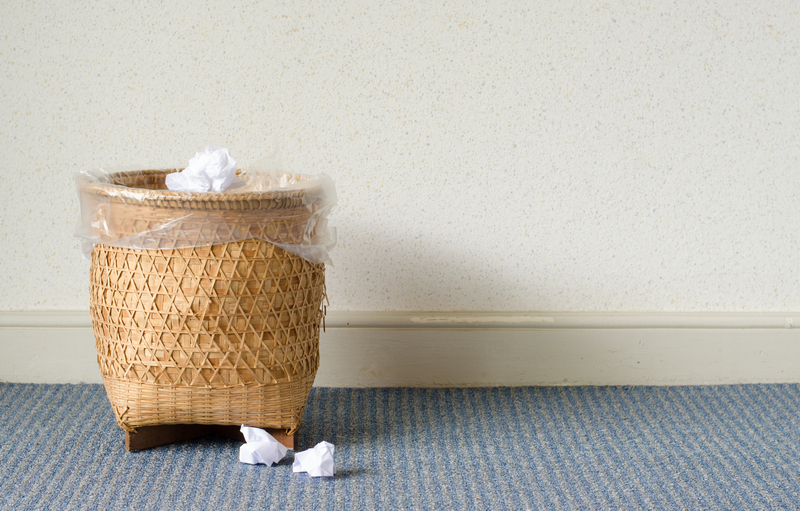Making PPE Waste Disposal Part of Your Daily Routine
The global pandemic has made Personal Protective Equipment (PPE) an essential part of daily life for millions of people worldwide. Masks, gloves, face shields, and disposable gowns have become staples in healthcare settings, workplaces, and even at home. But with this increased use comes a new challenge: managing and disposing of PPE waste responsibly. Are you making PPE waste disposal part of your routine? If not, now is the perfect time to learn why it matters and how you can incorporate safe, environmentally friendly PPE disposal into your everyday habits.
Why Proper PPE Waste Disposal Is Crucial
Improper PPE waste disposal poses serious health, environmental, and societal risks. While PPE is vital for protecting against pathogens, once used, it can harbor dangerous contaminants. Let's explore the top reasons to prioritize the safe disposal of PPE:
- Health and Safety: Used PPE can transmit viruses and bacteria if handled carelessly, putting waste collectors, the public, and even yourself at risk.
- Environmental Impact: Disposable masks and gloves made from plastics and synthetic fibers can take hundreds of years to decompose, polluting landfills and waterways.
- Wildlife Hazards: Discarded PPE is often found in parks, beaches, and oceans, where animals may ingest or become entangled in waste materials.
- Legal Compliance: Certain businesses and healthcare providers are required by law to follow PPE waste disposal protocols and can face fines for violations.
Fact: It's estimated that globally, we use 129 billion face masks and 65 billion gloves each month--an unprecedented volume that underscores the urgent need for responsible PPE waste management in our routines.

Understanding PPE Waste: Types and Challenges
What Counts as PPE Waste?
PPE waste isn't just limited to medical settings. Everyday items such as:
- Disposable masks
- Gloves
- Face shields
- Shoe covers
- Disposable gowns and aprons
- Protective eyewear
all constitute PPE waste once used.
Disposal Challenges
The surge in PPE usage has created unique disposal issues, such as:
- Mixed Materials: Many items are made from several types of plastics, making recycling difficult.
- Contamination: Used PPE is often contaminated with bodily fluids, chemicals, or pathogens.
- Littering: PPE is frequently discarded incorrectly, polluting streets, green spaces, and waterways.
Overcoming these challenges requires both education and actionable steps integrated into our daily routines.
How to Make PPE Waste Disposal a Daily Habit
Transforming PPE waste management from an afterthought into a routine practice ensures better public health and environmental outcomes. Here's how you can make a difference every day:
1. Designate a PPE Waste Bin
Set up a clearly labeled PPE waste bin in your home, workplace, or public space. Use a bin with a lid and lined with a plastic bag to reduce the risk of contamination and the spread of germs.
- Choose a noticeable color--red or yellow are often used for hazardous waste to remind everyone to dispose responsibly.
- Place the bin in easily accessible locations, such as entrances, exits, and high-traffic areas.
2. Separate PPE Waste from Recyclables
Always separate PPE from regular recyclables and household waste. PPE such as masks and gloves cannot be recycled in regular systems due to contamination risk.
- Never put used PPE into mixed recycling bins.
- Clearly mark and educate others about the importance of this separation.
3. Practice Safe Handling
When removing and disposing of PPE:
- Remove gloves and masks without touching the outside surfaces.
- Dispose of items immediately after use--do not reuse disposable PPE.
- Always wash your hands thoroughly for at least 20 seconds after handling.
4. Educate Your Family and Coworkers
Make sure everyone in your household or workplace understands the proper way to dispose of PPE waste. Use posters or reminders to reinforce good habits.
5. Minimize Single-Use PPE When Possible
Consider using washable, reusable masks and face shields when appropriate. This drastically reduces the volume of PPE waste generated.
- Follow local health guidelines to choose when reusable PPE is safe and effective.
- Make sure to clean and sanitize reusable PPE regularly according to manufacturer instructions.
6. Participate in PPE Recycling Programs
Some cities, organizations, and companies now offer PPE recycling. Check for drop-off points or mail-in programs that accept used masks and gloves for specialized processing.
- Read guidelines carefully--only send accepted items and follow preparation instructions.
- Encourage your workplace or community to partner with PPE recycling initiatives.
PPE Waste Disposal at Work and Public Places
For Employers and Facility Managers
- Place PPE disposal bins in visible, convenient spots such as entryways, break rooms, and restrooms.
- Train cleaning and janitorial staff in safe PPE handling and disposal practices.
- Schedule more frequent waste removal during peak usage periods to prevent bin overflow.
- Regularly communicate disposal protocols to staff and visitors.
In Public Spaces
Public spaces experience high volumes of PPE litter. Local governments and businesses can:
- Install labeled PPE disposal bins outdoors and in transit areas.
- Run public awareness campaigns on the importance of proper PPE waste management.
- Organize community clean-up initiatives to remove improperly discarded PPE from parks and streets.
The Environmental Impact of Improper PPE Disposal
Single-use PPE is predominantly made from plastic polymers (polypropylene, polyethylene, vinyl), none of which biodegrade quickly. When PPE waste ends up in nature:
- It breaks down into microplastics, contaminating soil, rivers, and oceans.
- Animals can mistake PPE for food, causing injury or death if ingested.
- Discarded masks and gloves clog drainage systems, exacerbating urban flooding.
The collective impact is staggering. Scientists have already recorded a surge in PPE pollution in marine environments, with discarded masks found on seabeds and beaches worldwide. Responsible PPE waste disposal is a critical step toward reducing this threat.
Innovative Solutions and Alternatives
PPE Recycling and Upcycling
Cutting-edge companies are developing new ways to recycle and upcycle PPE waste into useful products:
- Transforming melted PPE plastics into construction materials, such as bricks or tiles.
- Developing closed-loop recycling programs for specific types of PPE, like N95 masks or face shields.
- Encouraging manufacturers to design PPE from biodegradable materials.
The Role of Biodegradable PPE
The future of PPE waste reduction may rest in the adoption of biodegradable alternatives. Some manufacturers now offer masks and gowns made from plant-based fibers or compostable plastics.
- Biodegradable PPE is designed to decompose naturally within months, rather than centuries.
- Always look for certifications or third-party verification before purchasing biodegradable PPE.
Common Myths and Facts about PPE Waste
- Myth: PPE can go in regular household recycling.
Fact: Most PPE is not recyclable through standard streams and can contaminate recycling loads. - Myth: It's safe to throw PPE out anywhere. Fact: Littering PPE increases health risks and environmental harm.
- Myth: All disposable masks are the same for disposal. Fact: Surgical masks, N95 respirators, and cloth masks all have different guidelines for end-of-life management.
Regulatory Guidelines for PPE Waste Disposal
In many regions, there are specific PPE disposal regulations in place for both households and commercial entities:
- Used PPE from medical or quarantine settings must often be treated as hazardous (clinical) waste and incinerated.
- Businesses may be required to keep PPE waste separate and use specialized disposal services.
- Households are often directed to double-bag PPE and retain it for a period if contaminated before placing it in regular landfill waste.
Tip: Always check your local authority or health department website for current PPE waste disposal guidance.
Building a PPE Waste-Conscious Community
Creating a culture of responsible PPE waste management takes more than personal action--it demands a collective effort.
What You Can Do:
- Share PPE disposal best practices with friends, family, and coworkers.
- Advocate for visible PPE waste bins in your neighborhood, workplace, and favorite stores.
- Support businesses and organizations that prioritize and promote responsible PPE disposal.
- Volunteer for or organize local clean-up efforts targeting PPE pollution.
When everyone participates, the impact on our environment, public health, and daily life is profound. Let's all be part of the solution.

Conclusion: Make PPE Waste Disposal a Part of Life
Making PPE waste disposal part of your daily routine isn't just about personal protection--it's about safeguarding communities, preserving the environment, and ensuring a healthier future. As we continue to rely on PPE in our daily lives, let's commit to handling it responsibly every single time.
By designating PPE-specific disposal areas, educating those around us, following the latest disposal guidelines, and supporting innovative solutions, we can all contribute to a cleaner, safer world.
Start today: Make responsible PPE waste disposal a non-negotiable part of your daily routine and inspire others to do the same!
Frequently Asked Questions on PPE Waste Disposal
Can PPE be recycled?
Most PPE waste such as masks and gloves cannot be recycled through regular household systems due to contamination. Specialized programs do exist in some areas, so always check local resources.
Is it safe to burn used PPE at home?
No. Burning PPE at home can release harmful toxins. Always use officially designated waste disposal channels.
What should I do if I see PPE litter?
Wear gloves, use a tool (such as tongs), and dispose of PPE properly. Wash your hands thoroughly afterwards. Report large amounts of litter to your local authority.
Are cloth masks considered PPE waste?
Cloth masks are typically washable and reusable. Once damaged or worn out, they should be disposed of with general household waste, not recycling.
Share this guide with your network and help make every community a model of responsible PPE waste management.
